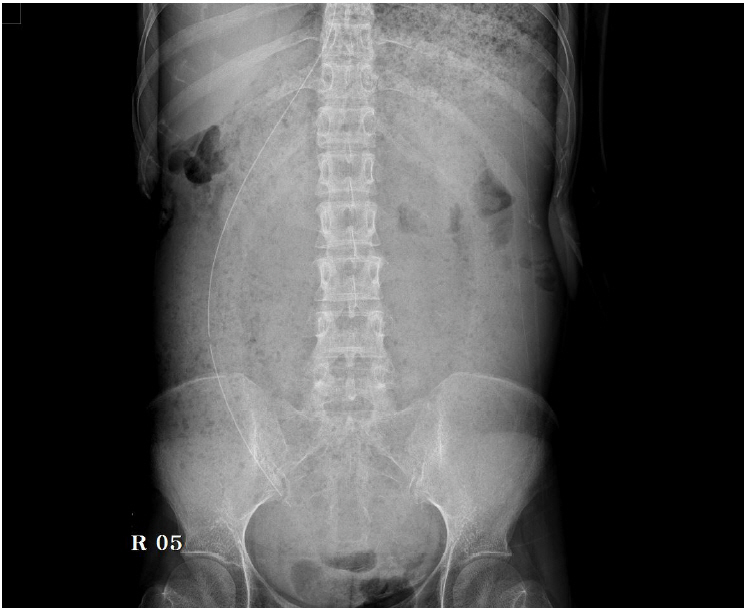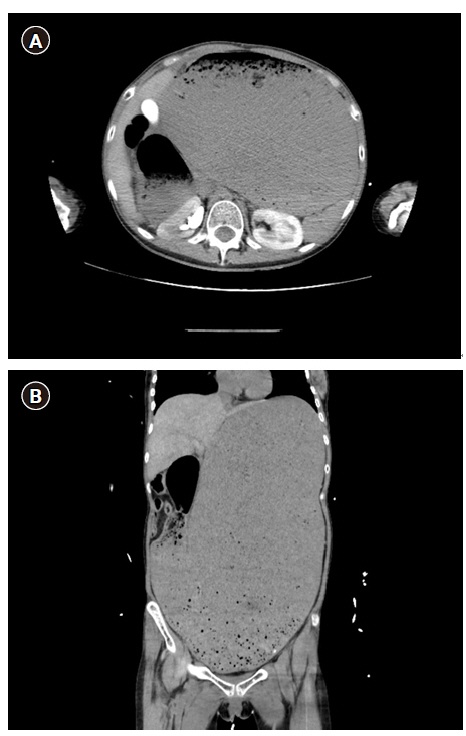Anesth Pain Med.
2020 Apr;15(2):251-258. 10.17085/apm.2020.15.2.251.
Abdominal compartment syndrome caused by gastric distension in bulimia nervosa and fatal injury following surgical decompression - A case report -
- Affiliations
-
- 1Department of Anesthesiology and Pain Medicine, Inha University School of Medicine, Incheon, Korea
- KMID: 2500980
- DOI: http://doi.org/10.17085/apm.2020.15.2.251
Abstract
- Background
Abdominal compartment syndrome (ACS) occurs due to increased abdominal cavity pressure, causes multiple organ damage, and leads to fatal consequences. Increased intraperitoneal pressure due to different reasons generally does not result in serious damage, due to the compliance of the abdominal wall. However, when the pressure exceeds the limit, ACS develops, thereby causing fatal damage to the organs. Case: A patient presented with rapid stomach swelling due to excessive food intake and was known to have bulimia nervosa, which had now resulted in ACS. Mental changes, abdominal distension, color change in the legs, acute kidney injury, and acidosis were seen. The patient expired due to ischemia-reperfusion injury and disseminated intravascular coagulation, which occurred after surgical decompression.
Conclusions
Under suspected ACS conditions, we should be aware of various symptoms that can occur. Early attempts for decompression are helpful, and it is important to be prepared for reperfusion injury prior to surgical decompression attempts.
Figure
Reference
-
1. Kim BS, Kwon JW, Kim MJ, Ahn SE, Park HC, Lee BH. Abdominal compartment syndrome caused by a bulimic attack in a bulimia nervosa patient. J Korean Surg Soc. 2011; 81 Suppl 1:S1–5.2. Youm SM, Kim JY, Lee JR. Acute gastric dilatation causing fatal outcome in a young female with eating disorder: a case report. Korean J Anesthesiol. 2015; 68:188–92.3. Kirkpatrick AW, Roberts DJ, De Waele J, Jaeschke R, Malbrain ML, De Keulenaer B, et al. Intra-abdominal hypertension and the abdominal compartment syndrome: updated consensus definitions and clinical practice guidelines from the World Society of the Abdominal Compartment Syndrome. Intensive Care Med. 2013; 39:1190–206.4. Prasad GR, Subba Rao JV, Aziz A, Rashmi TM. The role of routine measurement of intra-abdominal pressure in preventing abdominal compartment syndrome. J Indian Assoc Pediatr Surg. 2017; 22:134–8.5. Parsak CK, Sakman G. Acute gastric dilatation and abdominal compartment syndrome as complication of pyloric stenosis. Internet J Gastroenterol [serial on the Internet]. 2007; 5 [cited 2019 Jul 13]. Available from http://ispub.com/IJGE/5/2/6299/.6. Flores-Alvarez E, Avila-Cuevas GE, de la Torre-González JC, Rivera-Barragán V, López-Rodríguez JL, Reynoso-Talamantes D. [Early diagnosis and risk factors associated with abdominal compartment syndrome]. Cir Cir. 2005; 73:179–83. Spanish.7. Torquato JA, Lucato JJ, Antunes T, Barbas CV. Interaction between intra-abdominal pressure and positive-end expiratory pressure. Clinics (Sao Paulo). 2009; 64:105–12.8. Bailey J, Shapiro MJ. Abdominal compartment syndrome. Crit Care. 2000; 4:23–9.9. Saggi BH, Ivatury R, Sugerman HJ. Part XVI. Surgical critical care issues. In: Surgical treatment: evidence-based and problem-oriented. Edited by Holzheimer RG, Mannick JA: Munich, Zuckschwerdt. 2001. Available from https://www.ncbi.nlm.nih.gov/books/NBK6908/.10. Yoshikawa T, Kondo M. Free radicals in multiple organ failure. Jpn J Med. 1990; 29:683–5.11. Carden DL, Granger DN. Pathophysiology of ischaemia-reperfusion injury. J Pathol. 2000; 190:255–66.12. Sun MS, Jin H, Sun X, Huang S, Zhang FL, Guo ZN, et al. Free radical damage in ischemia-reperfusion injury: an obstacle in acute ischemic stroke after revascularization therapy. Oxid Med Cell Longev. 2018; 2018:3804979.13. Macalino JU, Goldman RK, Mayberry JC. Medical management of abdominal compartment syndrome: case report and a caution. Asian J Surg. 2002; 25:244–6.14. Muresan M, Muresan S, Brinzaniuc K, Voidazan S, Sala D, Jimborean O, et al. How much does decompressive laparotomy reduce the mortality rate in primary abdominal compartment syndrome?: a single-center prospective study on 66 patients. Medicine (Baltimore). 2017; 96:e6006.15. Morris JA Jr, Eddy VA, Blinman TA, Rutherford EJ, Sharp KW. The staged celiotomy for trauma. Issues in unpacking and reconstruction. Ann Surg. 1993; 217:576–84.
- Full Text Links
- Actions
-
Cited
- CITED
-
- Close
- Share
- Similar articles
-
- Abdominal compartment syndrome caused by a bulimic attack in a bulimia nervosa patient
- Repeated gastric dilatations leading to fatal abdominal compartment syndrome in a patient with bulimia nervosa
- Acute gastric dilatation causing fatal outcome in a young female with eating disorder: a case report
- A Case of Gastric Emphysema in Anorexia Nervosa Presenting as Acute Gastric Distension
- A Case of Acute Gastric Dilatation with Duodenal Obstruction Accompanying Elevated Serum Pancreatic Enzymes in a Patient with Bulimia




